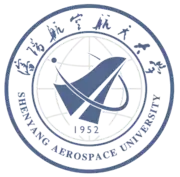Shenyang Aerospace University
Shenyang Aerospace University (SAU), formerly known as Shenyang Institute of Aeronautical Engineering, is a comprehensive research university in Shenyang, the capital of Liaoning province in Northeast China. It educates students for supporting the military and civil aviation industries of China.
沈阳航空航天大学 | |
 | |
| Motto | Virtuous, Capable, Brave and Perseverant. (德能并进 勇毅翔远) |
|---|---|
| Type | Public |
| Established | 1952 |
| President | Sun Xiaoping (孙小平) |
| Location | , |
| Campus | Suburban |
| Website | www |
| Shenyang Aerospace University | |||||||
|---|---|---|---|---|---|---|---|
| Simplified Chinese | 沈阳航空航天大学 | ||||||
| Traditional Chinese | 瀋陽航空航天大學 | ||||||
| |||||||
| Shenyang Institute of Aeronautical Engineering | |||||||
| Simplified Chinese | 沈阳航空工业学院 | ||||||
| |||||||
History
Founded in 1952, the university was initially administered by the Ministry of Aeronautical & Astronautical Industry, and later by the China General Corporation of Aeronautical Industry. Since 1999, SAU has been under the administration of the Liaoning Provincial Government and is the only university owned by the China Industry and Information Technology Ministry and the Liaoning Provincial Government. It is one of the eight universities constructed by the former China National Defence Ministry and local provincial governments. In addition, it is the only university of aeronautical and astronautical engineering in Liaoning Province.
On 18 March 2010 the China Ministry of Education approved the name change from Shenyang Institute of Aeronautical Engineering (SYIAE) to Shenyang Aerospace University (SAU).
Internationalization is one of the characteristics of SAU. The university has established cooperative agreements with 300 universities and companies from around the world. It has an active exchange program for both teachers and students.
Overview
Characterized by aeronautics and astronautics, Shenyang Aerospace University is a multi-disciplinary university, which, while focusing on engineering, also covers such areas as science, liberal arts and management. The university comprises 17 schools, with over 900 lecturers, including 400 professors and associate professors. There are 20,000 full-time students in SAU. The university has over 50,000 graduates, whose competence, loyalty and achievements have been well accepted by society. A great number of them are now working as senior engineers or executives. The recent employment of the graduates has been maintained at an average of 95.7%. Every year a large number of foreign students get admission in this university. The university employs a number of foreign talents who contribute to both the academic and cultural life of the school community. At present, there are over 1688 international students from 71 countries studying Aeronautical Engineering, Mechatronics Engineering, Computer Science and Technology, Telecommunication Engineering, International Economics and Trade and Chinese Culture, etc,. These students, with their diverse cultural backgrounds, contribute to the broad international focus of the university.
Undergraduate schools
- School of Aerospace Engineering
- School of Aero Dynamics and Energy Engineering
- School of Civil Aviation and Safety Engineering
- School of Mechanical and Electrical Engineering
- School of Computer Science
- School of Airforce Officials Training
- School of Electronics Information Engineering
- School of Auto Control
- School of Economics and Management
- School of Design Art
- School of Material Science and Engineering
- School of Science
- School of Foreign Languages
- International Education College
- School of Automation
- School of Robotics
Institutes
- Institute of "Beifang" Software
- Institute of "Beifang" Science and Technology
- Lifelong education
- Office of Social Science
- Office of PE Teaching & Research
- Training center of Korean Language
Graduate schools
- School of Aerospace Engineering
- School of Computer Science
- School of Information Communication
- School of Auto Control
- School of Mechanical Engineering
- School of Materials Science and Engineering
- International Education College
External links
- Official website (in Chinese)
- Official website (in English)